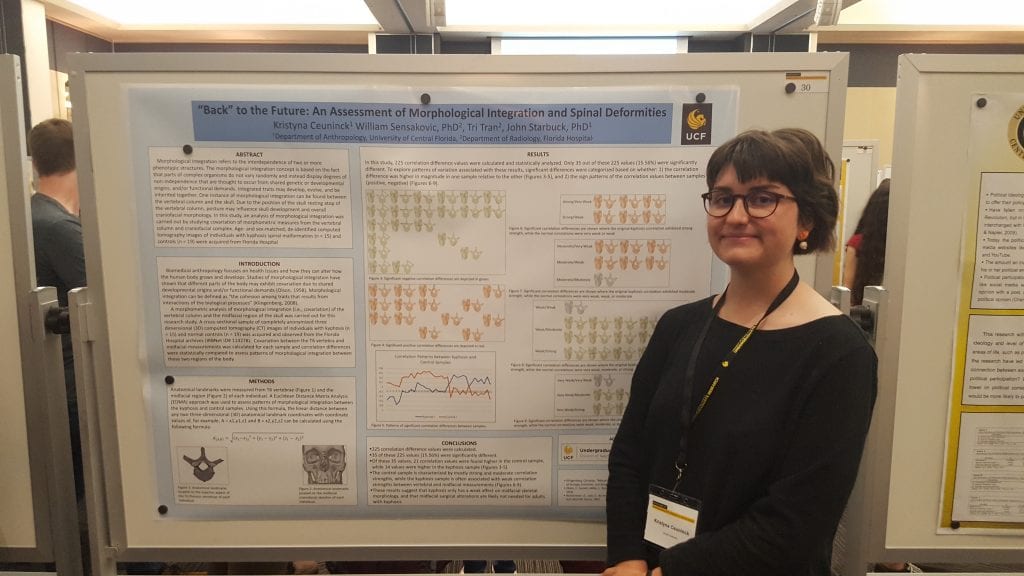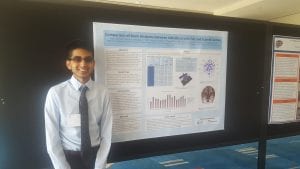Peer-Reviewed Papers Give Students Edge For Post-Graduation Careers

Kristyna Ceuninck
After taking their mentor’s advice, two UCF students have seen new opportunities open following the publication of their first peer-reviewed research papers.
Yaser Ahmad, a junior biomedical sciences major, and Kristyna Ceuninck, an anthropology Master’s student, both published peer-reviewed papers in Clinical Anatomy about unilateral cleft lip and palate, or UCLP. Helping them along the way was John Starbuck, Ph.D., a biological anthropologist, and an assistant professor at UCF since 2015.
Starbuck said to get into graduate or medical school, students need to do more academically than they did in the past.
“For graduate and medical school, they’ll look like stronger applicants with research and publications in their background,” Starbuck said. “That is an important step in preparing them for what they want to do.”
The competition is getting steeper. Between 2006 and 2016, the number of applicants to U.S. medical schools increased by more than 35 percent, rising from 39,108 to 53,042, according to Association of American Medical Colleges admissions data.
To help his students compete in the expanding anthropological and medical fields, Starbuck encourages them to get involved in research and publish papers — especially as undergraduate students.

Yaser Ahmad
Ahmad’s paper focused on understanding the extent to which the face can be symmetric after surgery for UCLP. Ahmad said the research was important because taking measurements and conducting analyses to assess asymmetry before and after the surgery can help predict the successes of future surgeries to improve craniofacial function and aesthetics.
Now Ahmad said he is working on a thesis project researching how Down syndrome influences brain shape by applying morphometric approaches to MRI images from AdventHealth.
“I hope to attend medical school and incorporate research into that,” Ahmad said. “This experience has ingrained that in me. I like the ability to work on a project that can have big implications and affect a lot of people.”
Ceuninck’s published paper also has impact beyond her personal resume. Ceuninck looked at the correlations between environmental and genetic influences of UCLP constructed during morphogenesis, or when a fetus is developing.
With this data, Ceuninck said it can help us understand what kind of illnesses to prevent for pregnant women and what doctors should look for in pregnancy to prevent UCLP.
Ceuninck said she now plans to work with archaeological Mayan skulls with intentional skull deformations – such as infant skulls that were artificially modified to form a distinct shape – to assess how relationships among skull parts change because of deformation. This skeletal collection is curated by associate Anthropology lecturers Sandra Wheeler and Lana Williams.
Ceuninck said she feels the point of anthropology is helping those who need it, and to actually do something in the field has been fulfilling. Not only does she feel like her research is helpful, but Ceuninck said the papers she publishes as a student will help her gain credibility in the future.
“I would argue papers give you stability when you graduate as an undergrad or graduate student because you can prove that you actually did something besides getting a degree,” Ceuninck said. “Publishing papers gets information out there and can help you network. I can use my research to open opportunities.”
Starbuck continues to mentor students as they write papers and expand the research community at UCF. While Starbuck said he would encourage faculty members to also mentor students if their schedule allows, he believes a successful research paper comes from dedicated students.
“The students I have in my lab are very good at starting a project and finishing it,” Starbuck said. “I would like to see students get more involved in research if possible and understand that research experiences will benefit them in the future.” Starbuck currently has twenty-three students working in his Image Analysis and Morphometrics laboratory located in Research Park.
Last summer, Starbuck was allotted new lab space in Howard Phillips Hall, where the department of anthropology is located. He hopes to move his lab in the near future when department funding becomes available to renovate the allotted space and move his laboratory equipment. He expects that this transition will make mentoring students and conducting research far more efficient.
“Currently, our department’s laboratories are spread all over campus, which can impair our ability to do research efficiently due to geographic distance and the inability to be in two places at once”, said Starbuck. Despite this handicap, Starbuck, and student researchers like Ahmad and Ceuninck remain productive. For Ceuninck, she said her research as a student has taught her to branch out beyond the classroom.
“One of the best things you can do is work on a research paper,” Ceuninck said. “Be willing to go outside of your comfort zone. It’ll be stressful and uncomfortable, but you adapt to it over time.”
